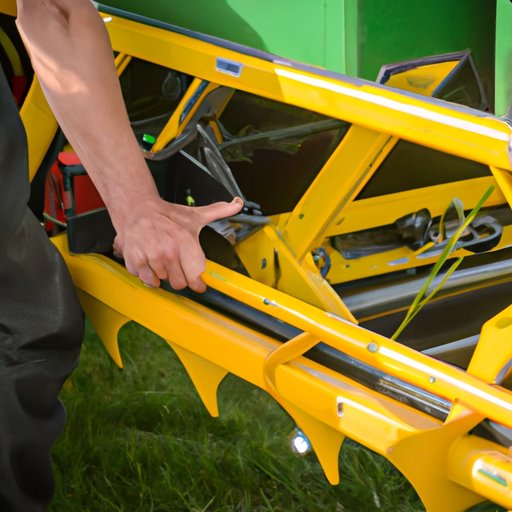Introduction
A combine harvester is a machine used to harvest crops like wheat, barley, soybeans, corn, and more. It’s a multipurpose agricultural tool that cuts the crop, threshes it, cleans it, and collects it into a container for storage or sale. Understanding the mechanics of a combine harvester is important for farmers and operators who want to maximize their efficiency when harvesting crops.
Exploring the Mechanics of a Combine Harvester
The components that make up a combine harvester include the cutting mechanism, a transport system, a threshing mechanism, a cleaning system, and a separating system. The cutting mechanism cuts the crop and delivers it to the transport system. The transport system conveys the crop to the threshing mechanism. The threshing mechanism separates the grain from the straw and chaff. The cleaning system removes dirt and other impurities from the grain. Finally, the separating system divides the grain from the straw and chaff.
Operating a combine harvester requires skill and knowledge. The operator must be familiar with the controls and settings of the machine, as well as how to adjust them according to the crop being harvested. They must also know how to properly position the combine for optimal performance. Additionally, the operator should have a working knowledge of the safety protocols associated with operating a combine harvester.
A Step-by-Step Guide to Harvesting with a Combine
Harvesting with a combine harvester involves a few steps. First, pre-harvest preparation is necessary. This includes checking the combine for any mechanical issues, topping up fuel and oil levels, and inspecting the blades and other components. During the actual harvest, the operator must ensure the combine is set up correctly and that the speed and direction are appropriate for the crop being harvested. After the harvest is complete, post-harvest maintenance is required. This includes cleaning out the combine, replacing worn parts, and lubricating the moving parts.
What Does a Combine Do?
Understanding the process and technology of a combine harvester is essential for efficient operation. A combine harvester has several functions. It cuts and collects the crop, threshes the crop to remove the grain from the straw and chaff, cleans the grain to remove dirt and other debris, and separates the grain from the straw and chaff. The combine then stores the grain in a container for sale or storage.
There are several types of combines available on the market. Self-propelled combines, which are powered by an internal combustion engine, are the most popular. These machines are designed to work in large fields and are capable of harvesting multiple crops at once. Track combines are designed to traverse rough terrain, while pull-type combines are towed behind a tractor and are suitable for smaller areas.

Maintenance Tips for Ensuring Your Combine Works Efficiently
Regular cleaning and lubrication are key components of maintaining a combine harvester. The operator should check the air filter and clean out any dust or debris that may have accumulated. The blades should also be sharpened regularly to ensure they cut through the crop easily. Additionally, all moving parts should be regularly lubricated to reduce friction and wear.
Scheduled maintenance checks are also important for keeping a combine in top condition. The operator should inspect the combine for signs of wear and tear and replace any worn parts. Additionally, they should check the machine’s fluid levels and top them up as needed. Troubleshooting common problems, such as clogged filters or low fuel pressure, can help prevent costly repairs.
Conclusion
This article has explored the mechanics and maintenance of a combine harvester. We discussed the components that make up a combine harvester, how to operate one, and a step-by-step guide to harvesting with a combine. We also discussed different types of combines and offered tips for ensuring your combine works efficiently. With this information, farmers and operators will be better equipped to maximize their efficiency when harvesting crops.
(Note: Is this article not meeting your expectations? Do you have knowledge or insights to share? Unlock new opportunities and expand your reach by joining our authors team. Click Registration to join us and share your expertise with our readers.)
